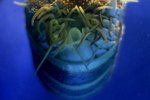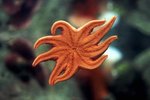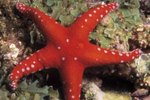
Invertebrate animal types categorized as mollusks include more than 50,000 different species living today. These creatures live in every possible environment on the planet. Only the arthropods are more numerous and diverse. Despite their diversity, mollusks share in common a three-part body plan that includes a head, a foot and a visceral mass.
The Head

The mollusk's head region contains the brain. In some mollusk species, such as those in taxonomic class Bivalvia -- the clams, oysters, scallops and mussels -- do not have clearly differentiated heads. In fact, these bivalves lack full brains and instead have only six paired ganglia. Ganglia are groups of nerve cells that help control movement. In comparison, mollusks belonging to class Cephalopoda -- octopuses and squids -- have relatively large, complex brains that can do simple problem-solving.
The Foot

A mollusk has a "foot," the body's muscular section, responsible for movement. The foot of some mollusks has also adapted to attaching to rocks and grasping prey. To ease movement, mollusks such as snails and slugs release secretions from their feet, then slide along the mucus, forming a trail. In cephalopods, the foot is divided into separate arms that can grow to 45 feet long in some species. Clams' and other bivalves' feet help them dig into the dirt for safety.
The Visceral Mass
The visceral mass includes all of the mollusk's organs. These organs include a three-chambered heart in most mollusks and three separate hearts in cephalopods. Unlike most mollusks, cephalopods have closed circulation system. All mollusks have highly developed tubes that perform their kidney functions. Mollusks also have one-way digestive tracts in which food travels from the stomach to the intestine and out the anus. Mollusks do not have fully developed lungs. Instead, aquatic mollusks breathe through gills, and land mollusks have membranes that operate like primitive lungs. Extending from the visceral mass is a protective tissue fold known as the mantle.
Shells

Many mollusks’ bodies are protected by shells produced through secretions from the mantle. Over time, these secretions build the layers that form the shells of snails, oysters and other mollusks. The same secretions create pearls. When an irritant, such as sand, gets into the area between the visceral mass and the mantle, the mantle responds by coating the irritant with these secretions, and a pearl begins to form.
References
- Oceanic Research Group: Snails and Their Relatives
- University of California Museum of Paleontology: The Mollusca
- Missouri Botanical Garden: Ocean Animals
- McGraw Hill Education: Mollusks and Annelids
- State University of New York: Flatworms, Mollusks, Annelids
- Tulane University: Lab 4 -- Molluscs and Annelids
- Encyclopedia Britannica: Ganglion
- World Animal Foundation: Octopus Facts
Photo Credits
-
Creatas Images/Creatas/Getty Images
Writer Bio
Amy Jorgensen has ghostwritten more than 100 articles and books on raising and training animals. She is also an amateur dog trainer. She has also written more than 200 blog posts, articles, and ebooks on wedding and party planning on behalf of professionals in the field.




